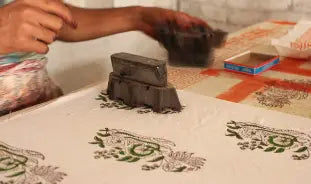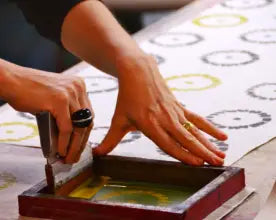Introduction of the Printing styles:
Textile printing is the intricate process of applying colour and patterns to fabrics. This design is bonded with the fabric's fibres to resist its extraction or removal while washing or friction. It is often confused with dyeing as they are closely related. Still, dyeing applies colour to the entire piece of fabric, while printing is just for specific areas and is more centric on patterns and designs.
Multiple tools and devices have been used over the decades for printing, some being wooden blocks, engraved plates, stencils, silkscreens, or even roller are often used to help with the block application on the textiles. There have been multiple different methods of textile printing, two of the most famous and widely used being hand block printing and screen printing.
Details of Hand block and Screen Printing and the difference between them:
Hand Block printing is a textile printing method that is done by carving a desired pattern or design onto a wooden block, after which this block is filled with the desired colour or dye for print. This block is then stamped onto the fabric to print the design. This method is much more suitable for printing intricate and detailed designs than using a brush, which may give a different level of precision and clarity.
Stone blocks are also a viable option for hand block printing, but wooden blocks are preferred, considering the ease and exactness with which it completes their tasks. Some examples of patterns printed by this method are flowers, animals, and several abstract designs.
Screen Printing, also known as silk screen printing, on the other hand, is also done by hand but is a process of printing and consists of applying dye onto a screen to fill in a design which is then transferred onto the fabric or textile. A blade is moved across the screen to fill the open pores of the screen with dye or colour, and this technique can be used to add multiple layers of colours and form various patterns as well.
Traditionally silk was used as the screen in this process, but over time this was changed to synthetic threads and those made of polyester. The screen printers are made from nylon or even stainless steel.
As mentioned, hand block printing uses wooden blocks, usually made of resources like Sheesham, Indian Rosewood, or even Teak, depending on the design's specifications and requirements. Screen Printing, on the other hand, requires stencils and screens for shifting and creating the designs on the selected fabrics. But the former is much more time-consuming and long-drawn, as opposed to the latter, because it is entirely done by hand and manually.
Screen printing requires the artisan's long wax tables and plenty of natural light to facilitate the screening process. The wax is used to help keep the fabric secure to the work platforms, while the light gives the artisans a clear view of their work and helps with blending and colour matching.
Block printing uses natural lighting and sunlight to dry the dye work done by the wooden blocks, which helps the fabric become soft, light, and supple.
The main difference which is evident between the two and can be drawn from their characteristics is that screen printing permits the formation of an etching of much more intricate and delicate detailing into the textiles and fabrics, as compared to those made by hand block printing. Among the two, block printing is the older and more traditional form of completing this process, and the tools used for both are very contrasting.
Textile Prints on iTokri:
iTokri has in the past and will continue to be a supporter of all the artisans and labourers that donate their time and talents to the arts of Hand block printing and well Screen printing. We house and display various products made by these three prostheses, even some that go beyond textiles used only for clothing. Some examples of screen printing products available would be Screen Printed Cotton Fabrics and fabric pieces made by Screen Print for Blouse pieces as well. These fabrics could be used for multiple purposes, mainly to enhance one’s wardrobe with some lovely and beautifully designed screen printed fabric Kurtis or traditional tops.
As for block-printed products, the variation is unmatched. There is an array of hand-block printed sarees of either cotton fabric, or even chanderi silk, to name a few, stoles, and even traditional shirts for men. iTokri also has a section for block-printed cushion covers that could be a gorgeous statement piece for any home and cotton table napkins. Considering that our vast selections entice you, we hope you will soon shop with us and help support the artisans and handicraft workers who put in their all to make the best they can!
FAQS:
-
What is textile printing?
Textile printing is the intricate process of applying colour and patterns to fabrics. This design is bonded with the fabric's fibres to resist its extraction or removal while washing or friction.
-
How is textile printing different from dyeing?
Textile printing is often confused with dyeing as they both are closely related. Still, dyeing applies colour to the entire piece of fabric, while printing is just for specific areas and is more centric on patterns and designs.
-
What is screen printing and hand block printing?
Hand Block printing is a textile printing method that is done by carving a desired pattern or design onto a wooden block, after which this block is filled with the desired colour or dye for print. This block is then stamped onto the fabric to print the design.
Screen Printing, also known as silk screen printing, on the other hand, is also done by hand but is a process of printing and consists of applying dye onto a screen to fill in a design which is then transferred onto the fabric or textile. A blade is moved across the screen to fill the open pores of the screen with dye or colour, and this technique can be used to add multiple layers of colours and form various patterns as well.
-
Are the main tools used for both processes different?
Hand block printing uses wooden blocks to print the design patterns onto the textile. On the other hand, screen printing uses a screen with designs and patterns, dyes, and blades to apply the colours.
-
Which of the two gives a more detailed and intricate printing on the fabric?
Screen printing is recommended for textiles requiring a more detailed and intricate printing pattern on the fabric.
-
Does iTokri have any products made from screen and hand block printing?
Yes, iTokri has these products. For Screen Printed Cotton Fabrics and fabric, pieces are made by Screen printing for Blouse pieces as well. In contrast, Hand block printing products include hand-block printed sarees of either cotton fabric, or even chanderi silk, to name a few, stoles, and even traditional shirts for men. iTokri also has a section for block-printed cushion covers that could be a gorgeous statement piece for any home and cotton table napkins.
Images:
Screen Printing:
Hand block printing:

Blogs you might also like:
The Prehistoric Period Interest in Indian Muslin Fabric
All You Need to Know About Dhokra Art
Ethnic Indian Home Decor - Mesmerising Crafts
REFERENCES
This Same Sky. (n.d.). Block and Screen Printing in Sanganer: A Brief Introduction.
Wikipedia contributors. (2022, October 22). Screen printing. Wikipedia.
https://en.wikipedia.org/wiki/Screen_printing
आई.टोकरी i. (n.d.). Search: 541 results found for “screen printing.” iTokri आई.टोकरी.
https://www.itokri.com/search?q=screen+printing
 Verified Purchase
Verified Purchase








































Leave a comment (all fields required)